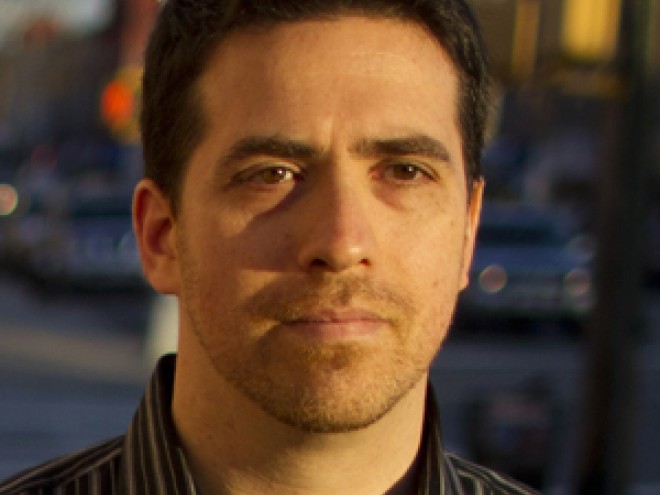Shulem Deen is the author of All Who Go Do Not Return, a memoir about growing up in and then leaving the Hasidic Jewish world. He will be blogging here all week for Jewish Book Council’s Visiting Scribe series.
I was raised within New York’s Hasidic community, where I spent the first 33 years of my life before rejecting the Hasidic worldview and leaving it for a mainstream secular life. Over recent years, however, I have been discovering that the world contains other types of Hasidim, completely different from the Hasid I had been. I call them the New Happy And Worldly Hasidim. (Or “NHAW Hasidim,” for short.)
Hasidic, for most of my life, meant something very specific and defined.
Hasidic meant speaking Yiddish. And shunning secular education. And men wearing shtreimels and sidecurls and speaking really bad English. And women keeping their heads shorn under their wigs and kerchiefs, and speaking slightly better English.
Hasidic meant arranged marriages, and meeting your future spouse for only half an hour before getting engaged, and knowing nothing about sex, or birth control.
Hasidic meant not only that you don’t watch TV or movies, but you barely know those things exist.
Hasidic also meant not only a certain kind of practice but a certain mindset, a determined detachment from the broader world, shunning all secular influences, and studiously avoiding engagement with outsiders.
Of course, Hasidim, the people, are different from Hasidism, the movement and the teachings that gave this society its name. The former are a group of people who form a particular culture. The latter is a set of ideas, which are accessible to anyone who can read the books. But it’s the people and how they live, rather than the ideas in the abstract, that, to me, give meaning to the term: Hasidic.
I remember first hearing about Matisyahu, the “Hasidic reggae superstar.” I was intrigued, but also baffled: why does he call himself “Hasidic” if he’s a “reggae superstar”? How was that even possible?

Matisyahu and Roots Tonic, 2007
Several years ago, a woman named Chaya wrote a widely-shared article on the website xoJane in which she claimed to be a Hasidic woman, and also, in her words, “a media professional with a degree in Women’s Studies from a large, very liberal university.”
In recent years, we’ve been hearing about an “all-female Hasidic rock band,” which has been playing to sold-out crowds at New York City clubs.
Not long ago, a friend recommended that I read the books of a self-described “Hasid” who writes about his love for the band R.E.M. This writer’s blog, I happened to notice, features a nifty drawing of a naked human butt drawn by one Pablo Picasso — something that could easily get you kicked out of every Hasidic shul I’ve attended.
In the Hasidic community that I have known, secular-influenced music is expressly forbidden. I’d never heard of Elvis Presley or the Beatles until well into my 20s. In my book—All Who Go Do Not Return—I describe how I had to sneak behind my then-wife’s back to listen to the radio in secret. And here was a “Hasidic reggae superstar.” And a “Hasid” writing about his love for R.E.M. And an all-female “Hasidic rock band” playing music that is clearly secular in its aesthetic, if not in its message.
In the Hasidic community I am from, attending college is anathema, let alone studying concepts like feminism. And here was a “Hasidic” woman with a degree in Women’s Studies.
And so, my first reaction to hearing about all these people was a kind of unease. Calling themselves “Hasidic” seemed dishonest. It also suggested a kind of smugness, as if denying the experiences of so many Hasidim — the vast majority, perhaps — who are raised with a rejectionist ideology: rejection of modernity, rejection of freedom, rejection of science and art and any passion that isn’t for God or the Torah; a rejection of our physical bodies, of any spiritual focus not rooted in our own traditions; a rejection of the rest of the world’s intellectual, emotional, spiritual, and creative contributions.
But the New Happy And Worldly Hasidim rejected none of those things.
So what made them Hasidim?
“We follow Hasidic teachings,” they say. I know they say this because I’ve had conversations with some of them. “We follow the Baal Shem Tov!” they tell me. “And there’s nothing in the Baal Shem Tov’s teachings about rejecting modernity.”
They have a point. Hasidism is a philosophy without strict markers, a movement that split into different streams and sects and was further subject to ideological waves engulfing some segments due to various historical processes, but not others.
It might be helpful to get straight this point of socio-historical arcana: there is little about the majority of Hasidic communities today that reflects the teachings of the early Hasidic movement. This cannot be said more plainly: the people we generally refer to as Hasidic, its insular core — the Satmars, the Belzers, the Svkerers, the Vizhnitzers, and others — are shaped as much by the nineteenth century anti-Maskilic opposition to religious innovation than by the teachings of the Baal Shem Tov, the founder of the Hasidic movement.
Hasidism, in its earliest incarnation, was not only spiritually and philosophically innovative but encouraged a rejection of conformism. There are tales of early Hasidim who danced naked in the streets and performed somersaults in the public square as a form of self-abnegation and a rejection of the ego. Some of these tales are probably apocryphal, but it’s fair to say they reflect a world in which “Hasidic” meant something entirely different from what it means today. No one’s doing naked somersaults on the streets of Borough Park.
There are historical explanations for the movement’s shift, but ignoring this fact seems like an attempt to sugarcoat some of the uglier realities of the present-day Hasidic world. And there’s something glib about those who choose an identifier while behaving in ways that are anathema to the mainstream known by it — or, at best, only permitted on the fringes.
The truth is, though, I like these New Happy And Worldly Hasidim, and I wish there were more like them. I love that there are people who can envision a “Hasidic” society that is open to the world, embraces creativity and a more expansive form of spirituality and a more progressive worldview. I wish that they — the New Happy And Worldly Hasidim — were the Hasidim who mattered in most Hasidic communities today. But they don’t; as things are now, the Hasidic world — its insular core — is deeply problematic. Right now, in Borough Park and Williamsburg and Monsey and New Square and Kiryas Joel — the largest Hasidic communities in the United States — there are few of these New Happy And Wordly Hasidim; and those who choose to be like them are bound to suffer real consequences.
I am not an identity purist, and I am happy to call anyone a “Hasid” if he or she self-identifies as such. But I also think that language matters, and we need to be specific about terms we use. I love the NHAW Hasidim who seem to be doing wonderful things in their own way. But they’ll have to forgive me if I choose to qualify the term “Hasid” before applying it to them. And New, Happy, and Worldly are good qualifiers to have, I think.
Shulem Deen is the founding editor of Unpious, an online journal for voices on the Hasidic fringe. His work has appeared in Salon, The Brooklyn Rail, Tablet Magazine, The Jewish Daily Forward, and elsewhere. He serves as a board member at Footsteps, a New York City-based organization that offers assistance and support to those who have left the ultra-Orthodox Jewish community. He lives in Brooklyn, New York.
Related Content:
- The Ultra-Orthodox Backlash by Leah Vincent
- The Pious Ones: The World of Hasidim and Their Battles with America by Joseph Berger
- A House Divided by Matthew Shaer
Shulem Deen is a former Skverer Hasid and the founding editor of Unpious. His work has appeared in The Jewish Daily Forward, Tablet, and Salon. He lives in Brooklyn, NY.


